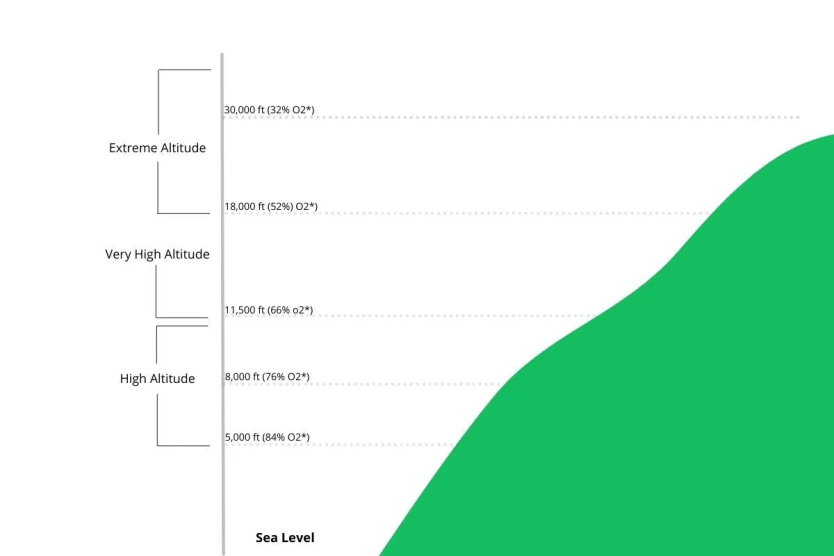Altitude sickness in Nepal affects approximately 50% of travelers on high-altitude treks, making it a prevalent and serious concern. To ensure a safe journey, it’s crucial to educate and prepare yourself for this condition ahead of time.
In Nepal, altitude sickness arises when travelers ascend to higher altitudes without adequate acclimatization. This condition is a consequence of the thin air, characterized by low oxygen levels in the atmosphere.

Altitude sickness is a common and serious concern for trekkers in Nepal, especially on high-altitude journeys like the EBC Trek. The risk intensifies as you ascend from “High altitude” (above 2750 m) to “Very high altitude” (above 3500 m), with most experiencing severe symptoms at the latter stage.
Altitude sickness encompasses Acute Mountain Sickness (AMS), High Altitude Cerebral Edema (HACE), and High Altitude Pulmonary Edema (HAPE). Rapid elevation gains, combined with diminishing oxygen pressure above 2500 m, can be life-threatening.
This guide aims to help you recognize, manage, and treat altitude sickness. It emphasizes the importance of preventive measures, crucial for tackling Nepal’s challenging terrains and ensuring your safety during treks in regions like Everest, Annapurna, Langtang, Manaslu, Upper Mustang, Kanchenjunga, Dhaulagiri, and more.
Altitude sickness, also known as “mountain sickness,” occurs at elevations ranging from 1,500 to 2,000 meters (4,921 to 6,562 feet) above sea level due to reduced oxygen pressure as you ascend to higher altitudes. This blog provides essential information on the risks, symptoms, complications, and effective strategies to mitigate altitude sickness during your trekking adventures in Nepal.
Understanding Altitude Sickness (AMS) in Nepal: Symptoms and Treatment
Altitude sickness, also known as Acute Mountain Sickness (AMS), is a common issue in Nepal, particularly at elevations exceeding 4,000 meters. However, mild symptoms can manifest as early as 2,750 meters or higher, usually within 6-12 hours of reaching such altitudes.
Common Symptoms of Altitude Sickness (AMS) Include:
- Headaches
- Fatigue
- Loss of appetite
- Nausea and vomiting
- Tingling sensations
- Dizziness
- Shortness of breath during exertion
- Nosebleeds
These symptoms can vary based on factors such as the rate of altitude gain, time spent at higher elevations, age, weight, blood pressure, respiratory capacity, and previous experience with high altitudes.
Treatment for Altitude Sickness in Nepal:
- Immediate Rest: If AMS symptoms appear, halt your ascent, and rest for at least half an hour.
- Hydration: Maintain proper hydration by drinking plenty of water and fluids.
- Gamow Bag: In severe cases, a Gamow bag can be used to increase atmospheric pressure around the affected person, often used by mountaineers.
- Pain Relief: For discomfort, consider taking pain relievers like acetaminophen (e.g., Tylenol) or ibuprofen (e.g., 500 mg).
- Medication: Acetazolamide, taken at 250 mg twice daily, can help increase your breathing rate and alleviate symptoms.
- Descent: If symptoms persist or worsen within 24 hours, descend 500-1000 meters to lower altitudes. Once your body adapts, you can resume trekking.
AMS is the result of reduced oxygen and lower atmospheric pressure impacting the body. Its symptoms can include nausea, dizziness, blocked ears, headaches, fatigue, loss of appetite, insomnia, discomfort, and a rapid heartbeat.
Understanding AMS and being prepared to manage it is crucial for trekkers in Nepal’s high-altitude regions, ensuring a safe and enjoyable adventure.
Recognizing Severe Altitude Sickness Complications in Nepal and Prevention Strategies
As you ascend to higher altitudes in Nepal, the risk of severe altitude sickness complications increases. Acute Mountain Sickness (AMS) can escalate to severe conditions like High Altitude Pulmonary Edema (HAPE) or High-Altitude Cerebral Edema (HACE). Recognizing the symptoms of these severe complications is crucial:
Symptoms of Severe Altitude Sickness Complications:
- Blurred vision
- Tight chest
- Fainting
- Fever
- Persistent cough with pinkish sputum
While trekking typically doesn’t lead to such severe cases, it’s essential to be vigilant about altitude sickness when visiting high-altitude regions in Nepal.
High Altitude Cerebral Edema (HACE):
HACE is a critical condition where the brain swells with fluid due to high-altitude exposure. Symptoms may include a dry cough, nosebleeds, shortness of breath, fever, chest tightness, rapid heart rate, congestion, swelling, and fainting.
High Altitude Pulmonary Edema (HAPE):
HAPE involves the swelling of the lungs with fluid due to high altitude. Symptoms can encompass hallucinations, loss of consciousness, fever and fatigue, photophobia, hypertension, confusion, coma, shortness of breath, and difficulty walking.
Promptly addressing any of these symptoms is crucial to prevent severe consequences, including coma or death resulting from delayed altitude sickness treatment.
Now, let’s explore preventive measures to minimize the risk of high-altitude sickness, ensuring an enjoyable and safe trip to Nepal.
Altitude Sickness Prevention: Your Guide to a Safe Trekking Experience in Nepal
Trekking in Nepal’s high-altitude regions offers breathtaking beauty, but it also comes with the risk of altitude sickness. To ensure a safe and enjoyable journey, follow these essential altitude sickness prevention measures:
- Ascend Gradually: Ascend slowly, allowing your body to acclimatize. Rest for a day after reaching 3,000 m and then after every 1,000 m gain in elevation. Descend 300-400 m for sleeping from the highest point you reached that day.
- Stay Hydrated: Drink plenty of fluids, especially water, to combat dehydration at high altitudes.
- Carbohydrate Intake: High altitudes demand extra energy, so consume extra carbohydrates while trekking.
- Gradual Altitude Gain: Avoid rapid ascents above 2,750 m. Come down to sleep even if you’ve climbed higher during the day.
- Special Care: If someone in your group experiences altitude sickness symptoms, take it seriously.
- Seek Medical Help: If symptoms persist or worsen despite rest, call for medical assistance.
- Avoid Substances: Refrain from smoking, alcohol, and sleeping pills, as they hinder acclimatization.
- Light Exercise: Don’t engage in heavy exercise at high altitudes.
- Trek with Others: Never trek alone, and inform your guide or a trusted person if anything seems unusual.
- Medication: Consider taking Acetazolamide (250 mg twice daily) to prevent altitude sickness.
- Adhere to Safe Altitude Gain Rules: Do not ascend more than 304 m/1,000 ft in altitude per day.
- “Climb High, Sleep Low”: Ascend during the day but sleep at a lower altitude to allow your body to adapt.
- Balanced Diet: Maintain a diet rich in carbohydrates to provide your body with energy.
- Hire Experienced Guides: Experienced guides offer valuable knowledge and monitor your health.
- Respond to Symptoms: Pay attention to altitude sickness symptoms and move to a lower altitude if they occur. Rest for a day or two at a lower altitude to recover.
- Carry First Aid: Bring necessary first aid items, including altitude sickness medications, and test local remedies before use.
Prevention is key when it comes to altitude sickness. Consult with medical professionals before your trek, and always prioritize your safety while exploring Nepal’s high-altitude wonders. With these precautions, you can enjoy a remarkable journey while minimizing the risk of altitude-related issues.
Discover more from Nepal Travel Vibes
Subscribe to get the latest posts sent to your email.



